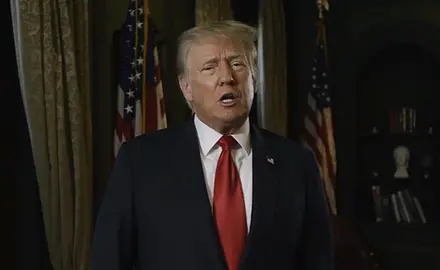Welcome to our weekly “Trumptastrophe” series that serves to remind us of the destructive policies, decisions, and actions we encountered during the Trump presidency and the threats that he and others in the MAGA movement still pose – and to keep those moments clear in our memory as we fight to defeat Republican extremists during the upcoming elections.
This week’s Trumptastrophe focuses on former President Trump’s history of cozying up to white nationalists – and his hesitancy to distance himself from them following the deadly protests in Charlottesville in 2017:
On Friday night August 11, 2017, torch-wielding white supremacists marched across the University of Virginia campus in Charlottesville, Virginia, chanting “Jews will not replace us!” They were in town for a white nationalist-organized “Unite the Right” rally the next day, where former KKK leader David Duke “declared that the scene in Charlottesville is a ‘turning point’ for a movement that aims to ‘fulfill the promises of Donald Trump.’”
When the protest led by white nationalists turned violent on Saturday morning and the governor of Virginia declared a state of emergency, Trump was uncharacteristically silent. James Fields, a 20-year-old from Ohio, rammed his car into a group of counterprotesters, killing Heather Heyer and injuring dozens of people.
That afternoon, Trump tweeted from his New Jersey golf club a short general condemnation of hate and violence. Two hours later he released a longer statement that said in part, “We condemn in the strongest possible terms this egregious display of hatred, bigotry and violence on many sides. On many sides.” As the Washington Post noted at the time, “Trump never used the words ‘white supremacy’ or ‘white nationalism.’” More from the Post:
Trump has long tiptoed around the issue of white supremacy and has yet to provide a full-throttled rebuke of those who invoke his name. He had to be repeatedly pushed to denounce Duke after the former KKK leader endorsed him and praised him.
Trump was silent on Sunday as outrage spread about his “many sides” comments. Under pressure, Trump did denounce violence from neo-Nazis and the “alt-Right” on Monday. But he was reportedly seething about what he believed was unfair media coverage of his response, and used a combative press conference the following day to repeatedly slam the media as “fake news.”
It was during that press conference that Trump responded to a reporter’s question about neo-Nazis who showed up in Charlottesville by saying “you had some very bad people in that group, but you also had people that were very fine people, on both sides.” In that press conference, he denounced neo-Nazis while claiming that there were also “very, very violent” people among the counterprotesters.
Trump also claimed the Friday night protest had featured people “protesting very quietly” plans to remove a statue of Confederate General Robert E. Lee, a claim refuted by the Washington Post’s fact-checker.
Trump’s response to the bigotry and violence of the far-right Unite the Right organizers reminds us why he has been, and remains, a threat to democratic values:
- When Trump first ran for president, the groups most energized by his campaign were conservative white evangelicals and white nationalists, who were electrified by his aggressively cruel rhetoric against immigrants. When Trump clinched the Republican nomination, the Neo-Nazi site Daily Stormer filled with posts celebrating what one called “Trump’s decisive victory over the evil enemies of our race.”
- In the Trump era, racist and antisemitic bigots have been emboldened to express their toxic hatreds openly on far-right streaming platforms, and MAGA Republican officials have repeatedly appeared at their events and on their programs.
- MAGA insider Michael Flynn and members of Trump’s family have repeatedly joined businessman Clay Clark in the ReAwaken America Tour, a traveling festival of radicalization which continues to expose thousands of MAGA activists to violent rhetoric from far-right purveyors of bigotry like Stew Peters.
- Donald Trump has continued to play footsie with his party’s far-right. In 2022, Right Wing Watch broke the story that Trump had just hosted Kanye West—already under fire for his increasingly vocal antisemitism— and white nationalist Nick Fuentes, who was familiar to Right Wing Watch readers but not most of the national media, which turned to Right Wing Watch for credible information on the far-right extremist who had entered Trump’s inner sanctum. Followers of Fuentes’s ideology have infiltrated right-wing media and local Republican Party positions.
- On August 5, Trump did an online interview with far-right online personality Adin Ross, who has promoted Fuentes and other white nationalists. As the Verge reported, Ross “was repeatedly banned from Twitch for using racial slurs before being permanently banned last year after featuring a chat stream where users spammed racial and antisemitic slurs. Ross migrated to the alternative streaming site Kick, where he continued his antics, which included hosting known white supremacist Nick Fuentes.”
Trump’s campaign, and MAGA movement leaders like Steve Bannon and Stephen Miller, attempt to build power with an inflammatory politics of grievance that tries to stoke racial resentments among white conservatives by convincing them that ethnic minorities are out to steal “their” country through immigration and programs designed to expand educational and economic opportunity.
Trump and the toxic MAGA ideology stand in the way of progress toward a multiracial, multiethnic, multireligious democracy where all people have the freedom, opportunities, and resources to share fully in the blessings of liberty.
These are just some of the reasons we need YOU in this fight. So, find your favorite way to unwind after reading through this week’s recap, and then make a plan for how you will fight back this week, this month, this election cycle.



